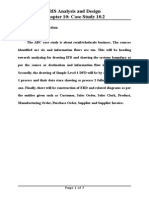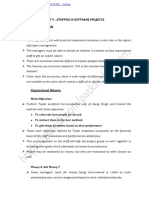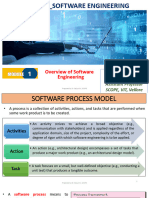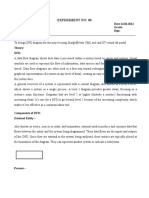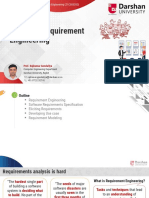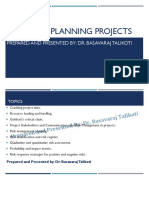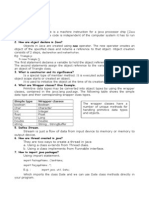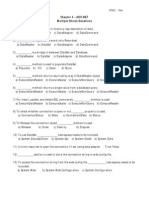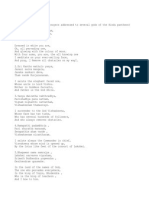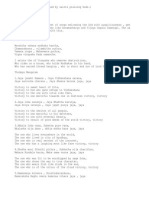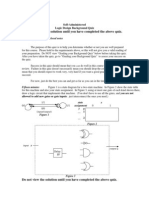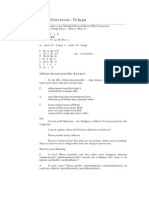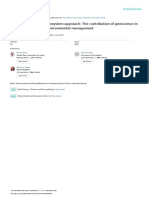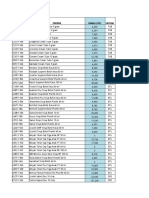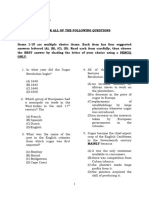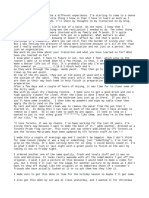Model-View-Controller (MVC) Design Pattern
Computer Science and Engineering College of Engineering The Ohio State University
Lecture 23
�Motivation
Computer Science and Engineering The Ohio State University
Basic parts of any application: Data being manipulated A user-interface through which this manipulation occurs The data is logically independent from
how it is displayed to the user
Display should be separately designable/evolvable
Example: grade distribution in class Displayed as both pie chart and/or bar chart Anti-example: see BigBlob Presentation, logic, and state all mixed together
�Model-View-Controller Pattern
Computer Science and Engineering The Ohio State University
Model The data (ie state) Methods for accessing and modifying state View Renders contents of model for user When model changes, view must be updated Controller Translates user actions (ie interactions with view) into operations on the model Example user actions: button clicks, menu selections
�Basic Interactions in MVC
Computer Science and Engineering The Ohio State University
Input Controller change data user action change display
Model
View Output
�Implementing Basic MVC in Swing
Computer Science and Engineering The Ohio State University
Mapping of classes to MVC parts
View is a Swing widget (like a JFrame & JButtons) Controller is an ActionListener Model is an ordinary Java class (or database)
Alternative mapping
View is a Swing widget and includes (inner) ActionListener(s) as event handlers Controller is an ordinary Java class with business logic, invoked by event handlers in view Model is an ordinary Java class (or database)
Difference: Where is the ActionListener?
Regardless, model and view are completely decoupled (linked only by controller)
�Mechanics of Basic MVC
Computer Science and Engineering The Ohio State University
Setup Instantiate model Instantiate view
Instantiate controller with references to both
Has reference to a controller, initially null
Execution View recognizes event View calls appropriate method on controller Controller accesses model, possibly updating it If model has been changed, view is updated (via the controller) Example: CalcMVC CalcModel, CalcView, CalcController Note: View includes (gratuitous) reference to model Note 2: The example code has a bug! Can you find it?
Controller registers with view, so view now has a (nonnull) reference to controller
�Extended Interactions in MVC
Computer Science and Engineering The Ohio State University
Input Controller change data user action
I have changed View
Model
Output
give me data
�Extended Pattern
Computer Science and Engineering The Ohio State University
Background: Observer pattern One object is notified of changes in another In extended MVC, view is an observer of model Application within MVC Asynchronous model updates
Model changes independent of user actions Associated view must be notified of change in
order to know that it must update
A model may have multiple views
But a view has one model All views have to be updated when model
changes
�Mechanics of Extended MVC
Computer Science and Engineering The Ohio State University
Setup
Instantiate model
Instantiate view with reference to model Instantiate controller with references to both
View registers with model Controller registers with view
Has reference to view, initially null
Execution
View recognizes event View calls appropriate method on controller Controller accesses model, possibly updating it If model has been changed, it notifies all registered views Views then query model for the nature of the change, rendering new information as appropriate
�Problems with Classic MVC
Computer Science and Engineering The Ohio State University
Controller might need to produce its own
output
eg Popup menu
Some state is shared between controller
and view, but does not belong in model
eg Selection (highlighted text)
Direct manipulation means that user can
eg Scrollbar
interact (control) visual elements (views) intermingled in a GUI
Overall issue: Input and output are often
Result: View and controller are tightly coupled
�Delegate-Model Pattern
Computer Science and Engineering The Ohio State University
Model Data, same as before Delegate Responsible for both input and output A combination of both view and controller Many other names UI-Model Document-View
�Basic Interactions in Delegate Model
Computer Science and Engineering The Ohio State University
Input Controller change data user action change display
Model
View Output
�Basic Interactions in Delegate Model
Computer Science and Engineering The Ohio State University
Input Controller change data I have changed
Model
View Output Delegate
give me data
�Mechanics of Delegate Model
Computer Science and Engineering The Ohio State University
Setup Instantiate model
As with MVC, model does not know/care about UI
Instantiate delegate with reference to model
Execution Delegate recognizes event and executes appropriate handler for the event Delegate accesses model, possibly updating it If model has been changed, UI is updated Example: CalcV3 CalcModel, CalcViewController Note: CalcModel is exactly the same as with CalcMVC
�Notes
Computer Science and Engineering The Ohio State University
Litmus test: Swapping out user
interface
Can the model be used, without modification, by a completely different UI? eg Swing vs console text interface
Model can be easily tested with JUnit Model actions should be quick GUI is frozen while model executes Alternative: multithreading, which gets much more complicated
�Supplemental Reading
Computer Science and Engineering The Ohio State University
Sun Developer Network Java SE Application Design with MVC http://java.sun.com/developer/technicalAr ticles/javase/mvc/ OnJava article A Generic MVC Model in Java http://www.onjava.com/pub/a/onjava/20 04/07/07/genericmvc.html
�Summary
Computer Science and Engineering The Ohio State University
Motivation: Information hiding Data (state) vs user interface State should be agnostic of user interface Model-View-Controller Model contains state (data) View displays model to user (presentation) Controller modifies model (business logic) UI-Model Allows for tight coupling between view and controller Preserves most significant separation





